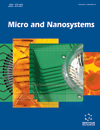- Home
- A-Z Publications
- Micro and Nanosystems
- Previous Issues
- Volume 16, Issue 1, 2024
Micro and Nanosystems - Volume 16, Issue 1, 2024
Volume 16, Issue 1, 2024
-
-
The Prospective Applications of Arising Nanostructured Dielectric Materials in Storage of Energy: A Comprehensive Review
More LessBackground: The manufacture and study of innovative materials that enable the availability of relevant technologies are vital in light of the energy demands of various human activities and the need for a substantial shift in the energy matrix. Objective: A strategy based on the creation of enhanced applications for batteries has been devised to reduce the conversion, storage, and feeding of renewable energy like fuel cells Read More
-
-
-
Synthesis and Characterization of V2O5 Nanorods Using Hydrothermal Method for Energy Application
More LessAuthors: Rupin Ranu, Kalyan B. Chavan, Sachin V. Desarada, Vikas K. Gade and Sukdeo L. KadamBackground: Nanomaterials are very useful in energy harvesting and energy storage devices. Morphological features play a vital role in energy storage devices. Supercapacitors and batteries are examples of energy storage devices. The working of a supercapacitor is decided by the nature of the microstructure and other features of the electrode material. Vanadium Pentaoxide (V2O5) is one of the promising materials due t Read More
-
-
-
Energy Optimization for RC and RLC Interconnect Design in Low Power VLSI
More LessAuthors: Himani Bhardwaj, Shruti Jain and Harsh SohalBackground: The global RC interconnects have become the controlling parameter for a circuit’s performance. But with the decrease in technology, an increase in resistance has become prominent. This increase further directly affects the performance of the system by increasing the performance parameters of the circuit like delay and power consumption. To resolve this issue and to be compatible with Internet of Thi Read More
-
-
-
Development and In vitro Assessment of Topical Microemulsion Based Pluronic-Lecithin Organogel for the Management of Arthritic Pain
More LessAuthors: Abhishek Yadav, Vikas Jhawat, Rahul P. Singh, Sunita Chauhan, Rohit Dutt, Rajesh Goyal and Deependra SinghBackground: Topical delivery of NSAIDs through organogels might transport lornoxicam to the site of action, minimizing gastrointestinal problems and adverse effects. Methods: In the current investigation, a lecithin organogel containing lornoxicam was made by microemulsion method. For this purpose, a certain amount of pure soya lecithin was dispersed in suitable isopropyl myristate as a dispersant and emulsifier at room tem Read More
-
-
-
Mechanical and Morphological Analysis of Aramid Fiber (PPTA), Glass Wool (GW), Aluminum (Al), and Silicon Carbide (SiC) Particles Embedded High-density Polyethylene (HDPE) Hybrid Composites
More LessAuthors: Rajib Ahmed, Mahbub Hasan, Md. Rezaul K. Sheikh and A. Nayeem FaruquiIntroduction: Composite research is adopting innovative materials in the current period due to their better qualities, such as being lightweight, having excellent mechanical properties, being relatively inexpensive, having a low coefficient of thermal expansion, etc. Methods: Composite materials play a crucial part in this challenge, with the fast market growth for lightweight and high-performance materials. In the presen Read More
-
-
-
Electrochemical Sensing of Vitamin C Using Graphene/Poly-Thionine Composite Film Modified Electrode
More LessBackground: Gastric irritation and kidney problems occur due to excess ascorbic acid content, whereas the lack of ascorbic acid in the human body leads to poor wound healing, muscle degeneration, and anemia. Objectives: Herein, we report the development of an electrochemical sensor for the detection of ascorbic acid using poly-thionine/ graphene (P-Th/Gr) modified glassy carbon electrode (GCE) in 0.1 M phosphate buffer Read More
-
Most Read This Month
Article
content/journals/mns
Journal
10
5
false
en


